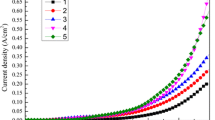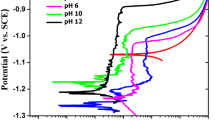Abstract
The effect of different Mn2+ and Pb2+ concentrations added to the zinc sulfate acid electrolyte during zinc electrowinning process was investigated. Operating parameters such as zinc ion concentration, acid concentration, current density, electrolyte agitation, and temperature were investigated in the presence of Mn2+ and Pb2+. Galvanostatic polarization, potentiodynamic polarization, cyclic voltammetry, and electrochemical impedance spectroscopy studies were performed to examine the cathodic behavior. Scanning electron microscopy (SEM) and X-ray diffraction (XRD) were employed to characterize the surface of the zinc deposit. The addition of lead ions to the zinc electrolyte led to an increase in the cathodic potential and current efficiencies of the zinc deposition. The addition of Mn2+ to the zinc electrolyte resulted in a decrease in the cathodic potential and current efficiency of zinc deposition. An increase in the current density from 45 to 60 mA cm−2 and in electrolyte agitation from 60 to 412 rpm resulted in an increase in the cathodic potential and decrease in current efficiencies. A temperature increase from 35 to 45 °C led to a decrease in the cathodic potential. After a short initial electrodeposition (2–4 h) using a Pb–0.7%Ag anode, the lead content in the zinc deposit was higher than that obtained with a Pt anode (0.15 mg L−1 Pb2+). A long deposition period of more than 72 h was also considered, and Pb content was almost the same in the zinc deposit for Pb2+ quantities (0.15 or 0.2 mg L−1).
Graphical Abstract

















Similar content being viewed by others
References
Sinclair RJ (2005) The extractive metallurgy of zinc. In: Sinclair R (ed), Australasian Institute of Mining and Metallurgy, pp 3–54
Alfantazi AM, Dreisinger DB (2001) The role of zinc and sulfuric acid concentrations on zinc electrowinning from industrial sulfate based electrolyte. J Appl Electrochem 3:641–646. doi:10.1023/A:1017569400346
Sorour N, Zhang W, Gabra G, Ghali E, Houlachi G (2015) Electrochemical studies of ionic liquid additives during the zinc electrowinning process. Hydrometallurgy 157:261–269. doi:10.1016/j.hydromet.2015.09.003
Ivanov I (2004) Increased current efficiency of zinc electrowinning in the presence of metal impurities by addition of organic inhibitors. Hydrometallurgy 72:73–78. doi:10.1016/S0304-386X(03)00129-4
Stefanov Y, Ivanov I (2002) The influence of nickel ions and triethylbenzylammonium chloride on the electrowinning of zinc from sulphate electrolytes containing manganese ion. Hydrometallurgy 64:193–203. doi:10.1016/S0304-386X(02)00037-3
MacKinnon DJ, Brannen JM (1977) Zinc deposit structures obtained from high purity synthetic and industrial acid sulphate electrolytes with and without antimony and glue additions. J Appl Electrochem 7(5):451–459. doi:10.1007/BF00615950
Bozhkov C, Petrova M, Rashkov S (1990) The effect of nickel on the mechanism of the initial stages of zinc electrowinning from sulphate electrolytes. Part II. Investigations on aluminum cathodes alloyed with iron impurities. J Appl Electrochem 20:17–22. doi:10.1016/S1003-6326(08)60357-X
Mansfeld F, Gilman S (1970) The effect of lead ions on the dissolution and deposition characteristic of a zinc single crystal in 6 N KOH. J Electrochem Soc 117(5):588–592. doi:10.1149/1.2407584
Mackinnon DJ, Brannen JM, Kerby RC (1979) The effect of lead on zinc deposit structures obtained from high purity synthetic and industrial acid sulphate electrolytes. J Appl Electrochem 9:55–70. doi:10.1007/BF00620587
Zhang Q, Hua Y (2009) Effect of Mn2+ ions on the electrodeposition of zinc from acidic sulphate solutions. Hydrometallurgy 99:249–254. doi:10.1016/j.hydromet.2009.09.002
Hosny AY (1993) Electrowinning of zinc from electrolytes containing anti-acid mist surfactant. Hydrometallurgy 32:261–269. doi:10.1016/0304-386X(93)90029-D
Zhang Q, Hua Y, Dong T, Zhou D (2009) Effects of temperature and current density on zinc electrodeposition from acidic sulfate electrolyte with [BMIM] HSO4 as additive. J Appl Electrochem 39:1207–1216. doi:10.1007/s10800-009-9786-5
Tripathy BC, Das SC, Singh P, Hefter GT (1999) Zinc electrowinning from acidic sulphate solutions. Part III: effects of quaternary ammonium bromides. J Appl Electrochem 29:1229–1235. doi:10.1023/A:1003459822142
Scott AC, Pitblado RM, Barton GW (1987) A mathematical model of a zinc electrowinning cell. In: Proceedings of the twentieth international symposium on the application of computers and mathematics in the mineral industries, metallurgy, vol 2. pp 51–62
Bratt GC (1977) A view of zinc electrowinning theory. In: Proceedings of the AusI.M.M. conference, Tasmania. Australasian Institute of Mining and Metallurgy, Melbourne, Australia, pp 277–290
Fosnacht DR, O’Keefe TJ (1980) Evaluation of zinc sulphate electrolytes containing impurities and additives by cyclic voltammetry. J Appl Electrochem 10:495–504. doi:10.1007/BF00614083
Hosny AY, O’Keefe TJ, Johnson JW, James WJ (1991) Correlation between mass transfer and operating parameters in zinc electrowinning. J Appl Electrochem 21(9):785–792. doi:10.1007/BF01402815
Ivanov I, Stefanov Y (2002) Electroextraction of zinc from sulphate electrolytes containing antimony ions and hydroxyethylated-butyne-2-diol-1,4: part 3. The influence of manganese ions and a divided cell. Hydrometallurgy 64:181–186. doi:10.1016/S0304-386X(02)00039-7
Tswuoka T (1960) Behaviour of manganese in the electrodeposition of zinc. Nippon Kogyo Kaishi 76:311–318
Milazzo G (1969) Électrochimie, Tome 1: Bases Théoriques. Applications Analytiques Électrochimie des Colloïdes. Dunod, Paris, pp 150–151
Fukubayashi H (1972) The effect of impurities and additives on the electrowinning of zinc. Doctoral Dissertations, University of Missouri, pp 41–50
Barton GW, Scott AC (1992) A validated mathematical model for a zinc electrowinning cell. J Appl Electrochem 22(2):104–115. doi:10.1007/BF01023811
Kelly RB, Scually JR, Shoesmith DV, Buchheit RG (2002) Electrochemical techniques in corrosion science and engineering. CRC Press, New York, p 53
Fletcher S (2009) Tafel slopes from first principles. J Solid State Electrochem 13:537–549. doi:10.1007/s10008-008-0670-8
Acknowledgements
Canadian Electrolytic Zinc (CEZinc), Hydro-Québec and Natural Sciences and Engineering Research Council of Canada (NSERC) are gratefully acknowledged for their financial support. The authors would like to express their sincere thanks and appreciation to Mr. Nabil Sorour and Mr. Ahmet Deniz Bas for their valuable advice and guidance, Mr. André Ferland for SEM analysis, Mr. Jean Frenette for XRD analysis, and Mrs. Vicky Dodier and Mr. Alain Brousseau for ICP analysis.
Author information
Authors and Affiliations
Corresponding author
Rights and permissions
About this article
Cite this article
Su, C., Zhang, W., Ghali, E. et al. Electrochemical investigation of electrolyte composition and electrolysis parameters during zinc electrowinning. J Appl Electrochem 47, 941–958 (2017). https://doi.org/10.1007/s10800-017-1091-0
Received:
Accepted:
Published:
Issue Date:
DOI: https://doi.org/10.1007/s10800-017-1091-0




